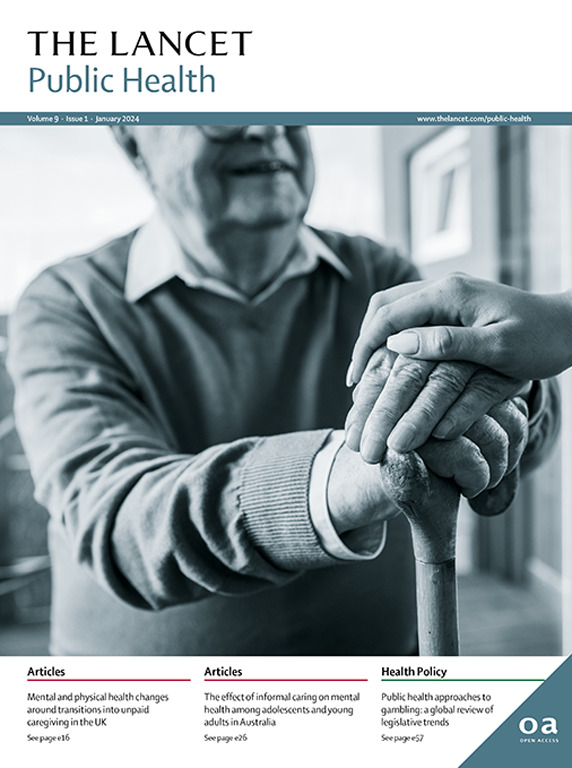Nicotine e-cigarettes for smoking cessation following discharge from smoke-free inpatient alcohol and other drug withdrawal services: a pragmatic two-arm, single-blinded, parallel-group, randomised controlled trial
IF 25.2
1区 医学
Q1 PUBLIC, ENVIRONMENTAL & OCCUPATIONAL HEALTH
引用次数: 0
Abstract
Background
Nicotine-containing electronic cigarettes (e-cigarettes) have been shown to be effective for smoking cessation among general populations, but there is little evidence in people with substance use disorders (SUDs). We aimed to assess the effectiveness of e-cigarettes for smoking abstinence in people with SUD following discharge from smoke-free inpatient withdrawal services.Methods
We conducted a pragmatic, two-arm, single-blinded, parallel-group randomised controlled trial. The majority of this study took place in the community after the participants were discharged from inpatient stay. Adults who were tobacco smokers (motivated to quit; not using e-cigarettes) from five smoke-free inpatient withdrawal services in Australia were recruited and randomly assigned by computer using stratified block (1:1) to receive a 12-week supply of either e-cigarettes or combination nicotine replacement therapy (cNRT) with Quitline behavioural counselling on discharge. Participants were advised to use e-cigarettes as much or as often as necessary or desired and cNRT according to instructions. Researchers collecting outcome data were masked to treatment group. The primary outcome was 7 months continuous tobacco smoking abstinence as measured at 9 months after randomisation. The primary analysis was performed using an intention-to-treat approach, with sensitivity analyses following per-protocol, treatment adherence, and complete case analysis approaches. Serious adverse events were classified by a physician as non-serious or serious and causality assessed. We analysed serious adverse events by treatment group and calculated an incident rate ratio for each comparison. This trial is completed and is registered with the Australian and New Zealand Clinical Trials Registry (ACTRN12619001787178).Findings
Between Sept 29, 2020, and June 3, 2022, 363 participants were enrolled. Of 363 participants, 207 (57%) were men and 151 (42%) were women; 179 (49%) were randomly assigned to e-cigarettes and 184 (51%) to cNRT. At follow-up, 19 (11%) of 179 participants in the e-cigarette group reported 7 months’ continuous abstinence, compared with 18 (10%) of 184 participants in the cNRT group, with no significant differences between groups (risk ratio 1·09; 95% credible interval [CrI] 0·52–1·89). The probability of a positive risk difference was 60% and Bayes factor was 0·04, indicating little evidence of a treatment effect. 15 serious adverse events occurred in the e-cigarette group and 13 occurred in the cNRT group (incident rate ratio 1·18; 95% CrI 0·56–2·54, p=0·65). None were treatment-related.Interpretation
There was no evidence of a difference in cessation rates or adverse effects after 9 months of follow-up between participants given e-cigarettes or cNRT following discharge from inpatient SUD withdrawal services. Both treatments had approximately 10% smoking continuous abstinence rates among a population that is hard to treat and who have disproportionate tobacco-related morbidity and mortality.Funding
National Health and Medical Research Council of Australia.尼古丁电子烟用于从无烟住院酒精和其他药物戒断服务出院后戒烟:一项实用的双臂、单盲、平行组、随机对照试验
含有尼古丁的电子烟(电子烟)已被证明对普通人群戒烟有效,但在物质使用障碍(sud)患者中几乎没有证据。我们的目的是评估电子烟对从无烟住院戒断服务出院的SUD患者戒烟的有效性。方法我们进行了一项实用的、双臂、单盲、平行组随机对照试验。这项研究的大部分是在参与者出院后在社区进行的。曾经吸烟的成年人(主动戒烟;从澳大利亚五家无烟住院戒断服务机构中招募不使用电子烟的患者,并通过计算机分层区(1:1)随机分配,在出院时接受12周的电子烟或尼古丁替代疗法(cNRT)联合戒烟热线行为咨询。研究人员建议参与者根据需要或需要尽可能多或频繁地使用电子烟,并根据指示进行cNRT。收集结果数据的研究人员被掩盖到治疗组。主要结局是在随机分组后9个月连续戒烟7个月。采用意向治疗方法进行初步分析,并根据每个方案、治疗依从性和完整病例分析方法进行敏感性分析。严重不良事件由医师分类为非严重或严重,并评估因果关系。我们按治疗组分析严重不良事件,并计算每个比较的发生率比。该试验已完成,并已在澳大利亚和新西兰临床试验登记处注册(ACTRN12619001787178)。在2020年9月29日至2022年6月3日期间,363名参与者被招募。在363名参与者中,男性207人(57%),女性151人(42%);179人(49%)被随机分配到电子烟组,184人(51%)被随机分配到cNRT组。在随访中,179名电子烟组参与者中有19人(11%)报告了7个月的持续戒烟,而184名cNRT组参与者中有18人(10%)报告了7个月的持续戒烟,两组之间没有显著差异(风险比1.09;95%可信区间[CrI] 0.52 - 0.89)。阳性风险差异的概率为60%,贝叶斯因子为0.04,表明治疗效果的证据很少。电子烟组发生严重不良事件15例,cNRT组发生严重不良事件13例(发生率比1.18;95% CrI = 0.56 ~ 2.54, p= 0.65)。没有一个是治疗相关的。解释:从住院SUD戒断服务中出院后,给予电子烟或cNRT的参与者在9个月的随访后,没有证据表明戒烟率或不良反应有差异。在难以治疗且与烟草相关的发病率和死亡率不成比例的人群中,这两种治疗方法都有大约10%的持续戒烟率。澳大利亚国家卫生和医学研究委员会。
本文章由计算机程序翻译,如有差异,请以英文原文为准。
求助全文
约1分钟内获得全文
求助全文
来源期刊

Lancet Public Health
Medicine-Public Health, Environmental and Occupational Health
CiteScore
55.60
自引率
0.80%
发文量
305
审稿时长
8 weeks
期刊介绍:
The Lancet Public Health is committed to tackling the most pressing issues across all aspects of public health. We have a strong commitment to using science to improve health equity and social justice. In line with the values and vision of The Lancet, we take a broad and inclusive approach to public health and are interested in interdisciplinary research.
We publish a range of content types that can advance public health policies and outcomes. These include Articles, Review, Comment, and Correspondence. Learn more about the types of papers we publish.
 求助内容:
求助内容: 应助结果提醒方式:
应助结果提醒方式:


